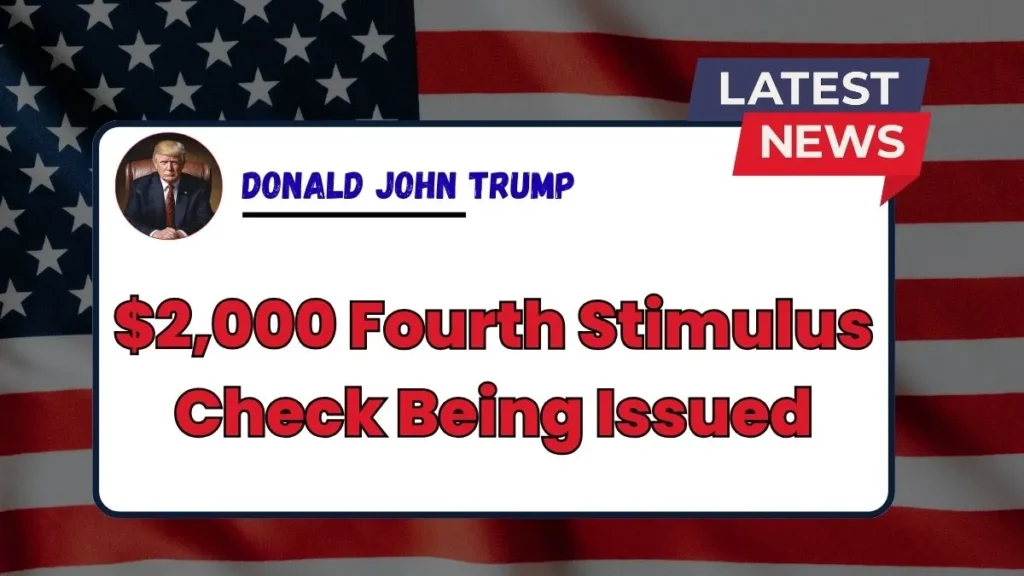The idea of a $2,000 fourth stimulus check for everyone has once again gained attention in Washington, D.C., as inflation continues to pressure American families. Lawmakers are considering direct financial relief to help households struggling with rising costs. The proposed payment would provide $2,000 per eligible adult, though no final legislation has been passed yet.
This renewed discussion highlights the urgent need to support citizens facing higher grocery, housing, and transportation expenses. Here’s what we currently know about eligibility, timing, and payment distribution.

Who Might Be Eligible for a Fourth Stimulus Check?
If Congress approves the plan, eligibility for the fourth stimulus check would likely resemble earlier programs. The IRS would manage payments using the latest tax returns and benefit records. In most cases, eligible recipients would include single filers earning under $75,000 annually, married couples filing jointly with incomes below $150,000, and heads of household earning up to $112,500.
Parents or guardians would qualify for added payments per dependent. Social Security, SSI, and SSDI recipients are also expected to be included. Payment amounts may increase based on household dependents.
Why Is the Stimulus Check Back on the Table?
Lawmakers are reconsidering stimulus checks because inflation, although lower than 2022 levels, continues to stretch household budgets. Families are struggling with persistently high costs for groceries, housing, medical care, and transportation.
While wages have grown modestly, they are not keeping pace with inflation, leaving many households vulnerable. Lawmakers believe another round of direct payments could bring temporary relief while boosting consumer confidence. The proposed $2,000 fourth stimulus check has become a central topic in current economic discussions.
Struggles Among Vulnerable Populations
Some groups are facing especially tough times, even with Social Security’s cost-of-living adjustments. Seniors, people with disabilities, and low-income workers report that higher monthly benefits still do not cover the cost of food, rent, or energy bills.
This financial gap makes daily living harder and forces many to rely on savings or debt. For these vulnerable populations, a fourth stimulus check could offer critical relief, helping them handle basic needs and avoid financial instability in uncertain times.
Softening Consumer Spending
Retail sales and small business revenues have slowed in recent months, raising concern among policymakers. Reduced spending weakens local economies, which depend on consumer demand to stay active. Economists argue that direct payments would quickly boost spending power, fueling growth in struggling businesses.
A fourth stimulus check would not only help households but also strengthen local economies by increasing purchases of goods and services. For lawmakers, this makes stimulus an attractive tool to stabilize communities.
How Much Would the Fourth Stimulus Be?
Current proposals suggest that each eligible adult could receive a $2,000 direct payment if approved by Congress. Dependents may also bring additional aid, ranging between $500 and $1,000 per child or dependent adult. These extra funds would benefit families with children or those supporting elderly parents.
While the exact amount depends on legislative approval, the goal is to provide meaningful financial help. For many households, this check could be a turning point in handling inflation-driven expenses.
When Could the Checks Arrive?
As of mid-2025, no law guaranteeing a fourth stimulus has passed. Should Congress approve the plan in the latter half of 2025, it may take the IRS several months to organize distribution. Payments could realistically begin by the end of 2025 or early 2026.
Like in past rounds, those with direct deposit set up would receive funds first, while mailed paper checks or debit cards could take longer. Timing depends entirely on how quickly lawmakers act on the proposal.
Other Support Programs to Watch
Even if the fourth stimulus check fails to pass, lawmakers may expand other programs. Families could benefit from an enhanced Child Tax Credit, while low-income households may receive assistance with heating bills through LIHEAP. Temporary SNAP increases could help cover rising grocery costs, and housing vouchers might ease rental burdens.
Programs extending unemployment aid may also resurface. These targeted relief measures would support households most affected by inflation, providing more immediate help than broad stimulus checks.
How to Prepare If a Fourth Check Is Approved
Households can take steps now to prepare in case the fourth stimulus check becomes law. Filing taxes promptly ensures accurate eligibility records with the IRS. Setting up direct deposit is recommended for faster delivery. Families should also monitor only official IRS updates to avoid scams.
If activated, the IRS “Get My Payment” tool can track the status of payments. Staying ready and informed means households won’t miss out if this relief effort receives final approval from Congress.
Last Thought
The $2,000 fourth stimulus check for everyone is not yet guaranteed, but it remains a strong possibility given today’s financial climate. Rising costs continue to strain families, seniors, and workers across the country. Whether through direct checks or alternative relief programs, lawmakers aim to ease this burden.
Staying informed, keeping financial details updated with the IRS, and preparing in advance ensures you are ready when assistance arrives. If approved, this stimulus could provide critical relief during challenging economic times.